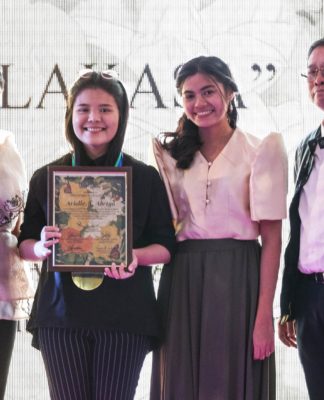THE ABORIGINAL Aytas of Tarlac are now slowly being consumed by westernization. But with the help of the UST Office on Community Development’s (OCD) Distance Learning Education (DLE) program by organizing annual celebrations of the Araw ng Katutubo, the Aytas are now being taught the importance of preserving their rich culture without severing any link or knowledge about the modern world.
With its green rolling hills and a majestic view of the Pinatubo in the horizon, Bamban, Tarlac has been the home of the indigenous Aytas for thousands of years.
Four years ago, Dr. Evelyn Songco of the Office of Student Affairs initiated the DLE program where professors and UST student volunteers immerse in native communities like the sitios of the Aytas in Tarlac.
Led by OCD director Joey Cruz III, head organizers Marielyn Quintana from the College of Education and Faculty of Arts and Letters professor Arlene Domingo and volunteer students trekked to the highlands of Bamban to wear their best bahags and baheles and dance the talipi with the Aytas.
For several years since its start in 2001, the celebration of the Araw ng Katutubo lasted only a day. This year, however, Quintana integrated a two-day activity program by the DLE before the actual celebration so that the students of both the DLE program and UST to establish a stronger friendship. Two days prior to the commemoration of the Indigenous People’s Day last Oct. 25 to 27, student volunteers and Thomasian professors through the Action Camp of the Thomasian Students Housing project, helped the natives make concrete houses to protect them against the frequent monsoon rains.
Seminars were also conducted to impose strict awareness and concern to natives about their culture and environment.
Other indigenous tribesmen, like Ramsey Astoreza, an Agtan (Dumagat) who came all the way from Infanta, Quezon were invited to participate and share their experiences.
During the celebration, four sitios (Sta. Rosa, Malasa, Mabilog and San Martin) exhibited their wedding and courting rituals through skits. Until now, the Aytas still insist on arranged marriages for their children.
Different tribal and local games, from Luksong Tinik, Sintak Babi (its counterpart would be the jackstones), and many more entertained the audience. But the Palosebo and the native archery presentation, which were already set up in the nearest basketball court, had to be canceled due to rains.
Restoring ancestral lands
The Catholic Church recognized the importance of recognizing the nation’s indigenous peoples’ roots a few years ago, declaring the month of October as the Indigenous People’s Month.
“The church sets aside a Sunday during October to celebrate the Indigenous People’s Day. On that particular day, all the sermons inside the church revolve around the natives,” Cruz said.
Though most of the OCD and DLE activities are concentrated in Tarlac, Quezon, Laguna, and Tondo, they still managed to reach out to Ayta communities living in Zambales.
In accordance with the Indigenous People’s Right Act (IPRA) that President Ramos passed in Oct. 22, 1997, the OCD, along with the National Commission for Indigenous People, has been securing Certificate of Ancestral Domain Titles (CADT) for the Aytas living in Zambales to ensure that the natives get back the lands that their ancestors had lived and hunted on.
“The certificate will cover 13 sitios, approximately 10,600 hectares. This is already approved, but the rewarding of the certificates is yet to be taken care of,” Cruz said. “It’s like saying graduate ka na pero hindi ko pa nabibigay sa iyo yung diploma mo. Those ‘diplomas’ will be handed out by the National Commission for Indigenous People.”
Disappearing culture
According to Cruz and Domingo, the commemoration of the Indigenous People’s Day is not just to preserve the slowly disappearing culture of the Aytas brought about by urbanization and Western influence, but also to instill a sense of pride, dignity, and belongingness to the natives, rather than to shame their ethnic roots.
“Hindi masama na magsuot ng bahag at gumamit ng pana pero hindi rin namin sinasabing bumalik sila sa dating pamumuhay. The only way to move forward is to acknowledge who our ancestors are, and accept that,” Cruz said.
According to an OCD census last year, there are 2,973 Aytas living in Bamban, with learning centers set up in the four principal sitios.
Nevertheless, the OCD, especially the teachers of DLE are careful in what they teach the Aytas in order not to dilute their “ethnic identity”.
“We always tell them, ‘In as much as you graduate from college, you are still an Aeta. You are Aeta teacher, you are an Aeta doctor,” emphasized Cruz. Domingo, one of the newly appointed teachers of the DLE Program, says that educating them is not easy. For one, it is a slow and continuing process where extreme patience is needed.
“It’s completely different to teach the natives because majority of them are already adults who do not know the Filipino alphabet. So you really have to start from the beginning,” Domingo explained.
Although Domingo and other teachers have sacrificed a lot of their time teaching, she is proud of the results.
“At least now, (the Aytas) will not be conned or cheated of what is due them. Now, they are more expressive about their opinions,” Domingo said. “We taught them the importance of education and confidence to speak up for their rights and opinions. For me, that’s a great achievement.”

















